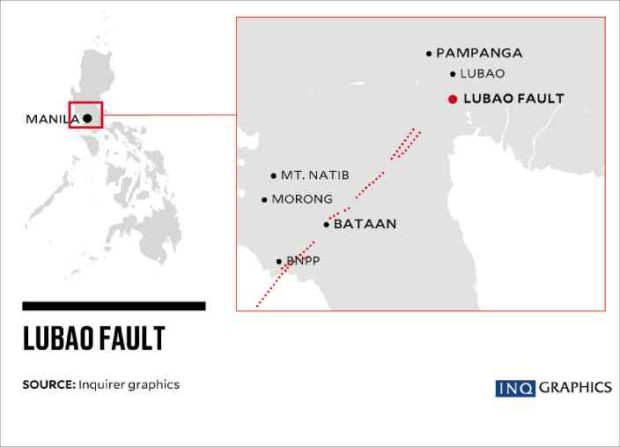Safety issues hound BNPP revival plan

WHITE ELEPHANT The Bataan Nuclear Power Plant, built using foreign loan, has not produced a single watt of electricity after the government shut it down in 1986 due to safety and corruption issues.—LYN RILLON
CITY OF SAN FERNANDO—A team of geologists will start a survey in June to confirm whether the Lubao fault line in Pampanga province extends to Napot Point, where the mothballed Bataan Nuclear Power Plant (BNPP) is located.
Dr. Fernando Siringan, director of the University of the Philippines Marine Science Institute, will lead the team that will explore the fault’s submarine extension and add to the country’s hazards data amid government plans to revive the nuclear plant.
Former President Corazon Aquino had shut down the BNPP in 1986 due to safety and corruption issues during the administration of the late strongman Ferdinand Marcos.
The 600-megawatt BNPP had not produced a single watt of electricity for Luzon, although the government spent $1.05 billion to build it, paid over P1 billion in interests for a loan and shelled out P40 million a year to maintain the plant.
Land sinking
Article continues after this advertisementGeologist Kelvin Rodolfo said he and Siringan’s team noticed the Lubao fault while studying the sinking of land off the coasts of the provinces of Bataan, Pampanga and Bulacan, and Caloocan, Malabon, Navotas and Valenzuela cities in Metro Manila.
Article continues after this advertisementOn Wednesday, Science Undersecretary Renato Solidum confirmed the offshore mapping of faults but said this was “not to map an extension of the alleged fault.”
“We have not seen evidence of an active fault in Natib and others doubt it, as well,” said Solidum, who also heads the Philippine Institute of Volcanology and Seismology (Phivolcs).
He and Rodolfo had been feuding after Solidum was quoted by a television news report as having said that the BNPP sat on “safe ground.”
Rodolfo said the Lubao fault “trends southwest to Mt. Natib, where it abruptly disappears.” He said Solidum “surely must be aware that the Lubao fault passes through Natib volcano and emerges at Napot Point.”
Hazards at BNPP
Solidum said he was interviewed by an ABS-CBN news team in March and “was asked about the hazards at BNPP.”
“I said safety has several considerations, such as location, design and construction. I stated there is no active fault beneath the nuke plant and that’s a fact,” Solidum told the Inquirer by telephone from Bacolod City. Natib, he added, was “not an active volcano.”
Rodolfo said a study by Dr. Janelli Soria used sediment cores and ancient sea-level data to document several meters of “vertical displacement at the lineament” to confirm the existence of the Lubao fault.
He said Dr. Mahar Lagmay and his UP students and colleagues spent many months in 2009 studying Natib and gathered isotopes leaking out of the Lubao fault.
Aside from demonstrating the earthquake hazard at BNPP, Lagmay’s team documented the “genuine hazards posed by a possible Natib eruption,” Rodolfo said.
“Faulting has broken and displaced large deposits of pyroclastic flows and lahars that underlie the plant. Lava also underlie the site, including flows that came out of a vent only 5.5 kilometers away from BNPP,” he said.
In 2017, Audrei Bonus-Ybañez reported “significant vertical deformation along profiles across the Lubao fault from her use of high-resolution seismic reflection reaching down to 250-meter depths.”
“Significant lateral movement also occurs along the fault, as Dr. Lagmay and his student Narod Eco discovered by analyzing satellite data,” Rodolfo said.
‘Air of legitimacy’
He said Solidum was giving an air of legitimacy to the campaign to activate the BNPP.
But Solidum said, “I am not for or against the BNPP.”
“We do not know what led or pushed Dr. Solidum to ignore and misrepresent the scientific facts, beyond recognizing that Phivolcs, like any government agency, is subject to budgetary pressures. We do know that activation of the BNPP poses the greatest threat to the well-being of the Filipino people and their environment,” Rodolfo said.
He urged the government to heed the lessons of the 2011 Fukushima Daiichi nuclear plant disaster in Japan where investigators concluded that the Tokyo Electric Power Co. had not met basic safety requirements.
“A major nuclear accident would gravely affect all surrounding countries. Consequently, the International Atomic Energy Agency (IAEA), of which the Philippines is one of 169 member states, must approve the activation. BNPP would never pass the rigorous [IAEA] standards,” Rodolfo said.
